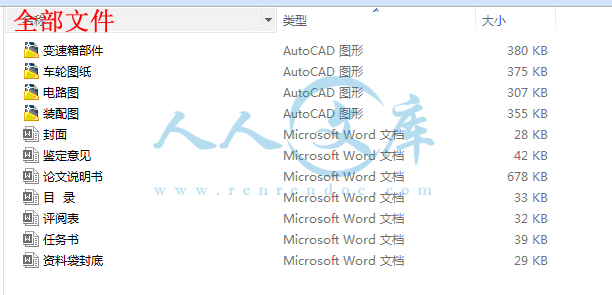目 录
摘要 ...................................................................................................................... 1
1 引言 ................................................................................................. 2
1.1 国内外发展情况 ............................................................................................. 4
1.2 设计内容 .....................................................................................................5
1.3 设计思路 ....................................................................................................5
2 系统方案 ....................................................................................................8
2.1 机械系统方案 ............................................................................................8
2.2 控制方案 ............................................................................................10
2.3 总体方案 .....................................................................................11
3 机械结构计 .........................................................................................12
3.1 链条的传动设计 ..................................................................................12
3.2 电动机的选用 ............................................................................12
3.3 驱动电路设计 ......................................................................................13
4 控制系统设计 ...........................................................................................14
4.1 控制系统软件设计 ..............................................................................14
5 总 结 ............................................................................................15
5.1 设计总结 .................................................................................... 15
参考文献 ............................................................................................... 16
翻译 ................................................................................................................... 17
致谢 ................................................................................................................... 26
摘 要
轮椅是年老体弱者以及下肢伤残者必不可少的代步工具,但障碍物却使轮椅受到很大限制。现代由于采用了传统的轮式结构,只能够在平地上行走,面对台阶、楼梯这样比较复杂的地形却显得无能为力。电动性轮椅设计是采用轮腿式机器人结构,正常行驶时轮式工作,采用四轮驱动;遇到障碍时腿式工作,从而适应大多数地形;车身则采用自动导轨式调平结构,该结构简单,调节方便。本次设计的主要工作包括:确定轮椅的工作方式以及工作结构形式、主体尺寸,并确定各主要零、部件的结构尺寸及其选型。
关键词:轮椅 电动轮椅 轮腿式机器人
Abstract
Wheelchairs are frail elderly and the disabled limb indispensable means of transport, but the obstacles while filling the wheelchair is very restricted. As with a traditional modern wheeled structure, can only walk on flat ground, facing steps, stairs, but this is more complex terrain powerless. High-pass design is the use of a wheelchair wheel legged robot structure, normal driving wheel work, the use of four-wheel drive; encounter obstacles leg work to accommodate most of the terrain; body is leveling automatic slide-type structure, the structure is simple, easy to adjust. The design of the main tasks include: determining wheelchair work and the working structure, body size, and identify the major components and parts of the structure size and selection.
Keywords: wheelchair high adoption round legged robot
一、引 言
1.1 电动轮椅国内外发展情况
随着社会的发展和人类文明程度的提高,人们特别是残疾人愈来愈需要运用现代高新技术来改善他们的生活质量和生活自由度。因为各种交通事故、天灾人祸和种种疾病,每年均有成千上万的人丧失一种或多种能力(如行走、动手能力等)。
随着人口的增长和医疗技术的进步,社会老龄化问题已成为很多国家不得不认真对待的重要问题之一。智能轮椅能够帮助老年人和残障人士独立的生活,节省家庭护理费用,减轻社会负担。许多国家投入较多资金研究智能轮椅,涌现出许多成果,但由于价格和实用性的原因使它们暂时只能作为实验产品。
智能轮椅作为移动机器人的一种,主要用来辅助老年人和残疾人的日常生活和工作,是对他们弱化的机体功能的一种补偿.智能轮椅在作为代步工具的同时又可以使用携带的机器手臂完成简单的日常活动.使他们重新获得生活能力,找回自立、自尊的感觉,重新融入社会.因而,智能轮椅的研究得到越来越多的关注
本设计的研究目标:在最经济的条件下,设计出一件最实用、最简易操作的电动轮椅,功能齐全、结构简单、适用于伤残人士、且能达到消费者需求水准的一件市场普及化产品。
主要特色:功能齐全、结构简便、使用方便、价格适当、安全系数强





 川公网安备: 51019002004831号
川公网安备: 51019002004831号